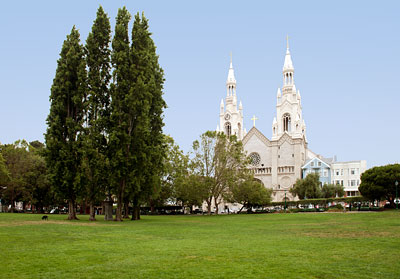San Francisco Landmarks
Washington Square Park
Stockton, Filbert, Columbus, Union
Built 1850
In 1847, when Jasper O'Farrell was commissioned to lay out the city's streets, he identified three city blocks as public squares, including the city block which later became known as Washington Square. In 1849, William Eddy resurveyed the City and published a widely distributed map showing the public squares. In 1850, the sites were set aside for the public by John W. Geary. It remained a tranquil, natural oasis as the City sprang up around it.
Washington Square is associated with important events in local and state history. The park was given its name during the patriotic years leading up to the Civil War and was the site of Fourth of July ceremonies. After the 1906 Earthquake and Fire, the park sheltered six hundred refugees.
Washington Square has hosted many special events, such as Fourth of July and Columbus Day celebrations, the start of the annual Blessing of the Fishing Fleet procession, and the North Beach Festival
The park is home to historically significant public art which recalls facets of California history - a granite block placed in 1869 as a United States Coast and Geodetic Survey Station; the Ben Franklin Statue, moved to the park in 1904, originally erected on Market Street in 1879 as a water fountain by temperance activist Henry G. Cogswell; a bronze sculpture of a man drinking water, crouched next to an artificial pond, a gentle reminder of the streams which once ran nearby; and the Volunteer Firemen Memorial, in honor of the Volunteer Fire Department of 1849-1866.
While the park's plantings and layout have undergone changes, neighborhood organizations have guarded the essential qualities of Washington Square. Thus, after almost 150 years, Washington Square is the only one of San Francisco's three original parks that has not been made into a roof top for an underground parking garage.
As it has for well over a century, Washington Square continues to serve as a green oasis as well as a cultural focal point for San Francisco's lively North Beach. Its continuing natural condition makes it highly significant as an historic resource within a densely urbanized area.
From City Planning Commission Resolution 14879 dated September 9, 1999.
